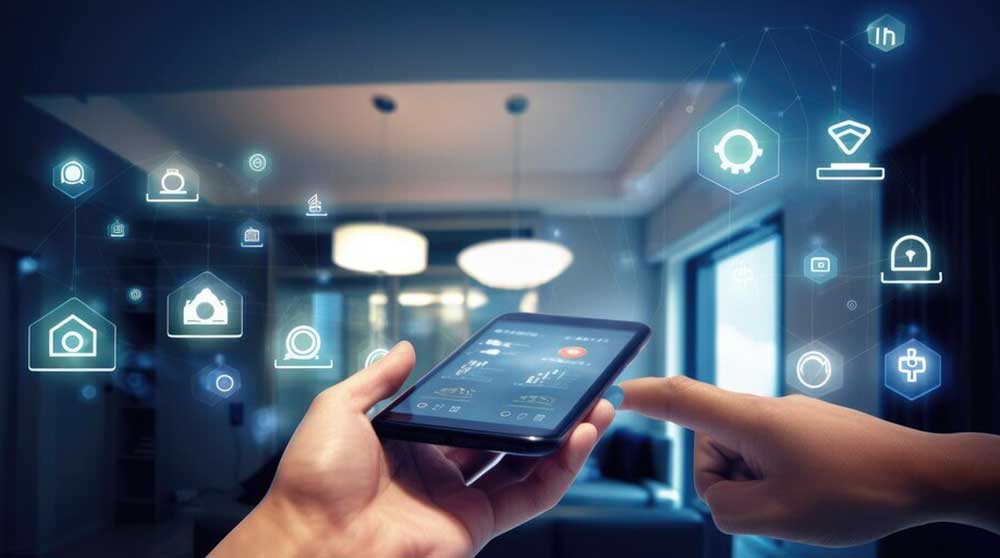The Internet of Things (IoT) has revolutionized our tech interactions, connecting everyday objects to the internet for data exchange. By 2025, IoT devices are projected to reach a staggering 75.44 billion worldwide (Statista).
IoT's impact isn't limited to one industry; it's reshaping many. In this blog, we explore how IoT is optimizing processes, reducing costs, and enhancing user experiences across sectors. We'll also delve into the pivotal role of IoT App development services, the driving force behind these innovations. Join us on this journey into the evolving world of IoT.
A. IoT Trends Redefining Industries
IoT’s impact goes far beyond mere connectivity—it’s a game-changer for industries that rely on data-driven decision-making and automation. Let’s explore how IoT is reshaping some key industries:
Healthcare: The healthcare industry is experiencing a seismic shift with the integration of IoT. Statistical Insight: According to Deloitte, 75% of healthcare organizations have IoT devices in production, highlighting the widespread adoption of IoT in healthcare. From remote patient monitoring to advanced medical devices, IoT is revolutionizing healthcare delivery. We’ll delve into how IoT is improving patient outcomes and transforming the healthcare landscape.
Agriculture: In the agricultural sector, IoT is optimizing crop management, resource allocation, and livestock monitoring. Statistical Insight: According to Markets, the global precision farming market, driven by IoT technologies, is expected to reach $12.87 billion by 2025. We’ll discuss how IoT-powered solutions are helping farmers boost yields while conserving resources.
Manufacturing: IoT is central to Industry 4.0, revolutionizing manufacturing with smart factories, predictive maintenance, and real-time monitoring. The Boston Consulting Group forecasts IoT's potential to bring manufacturers $4 trillion to $11 trillion in value by 2025, showcasing its significant influence. Discover how IoT boosts efficiency and reduces downtime in manufacturing with us.
Smart Cities: IoT is the backbone of smart cities, enabling intelligent infrastructure and efficient services. Statistical Insight: According to IDC, global spending on smart city initiatives is expected to reach $189.5 billion by 2023. From traffic management to waste management, we’ll examine how IoT is making urban living more sustainable and convenient.
As we journey through these industries, we’ll uncover the IoT trends and innovations that are reshaping the world as we know it. Moreover, we’ll spotlight the role of IoT App development services in bringing these innovations to fruition, ensuring that IoT solutions are not just connected but also functional, secure, and user-friendly.
B. Edge Computing and IoT
The Significance of Edge Computing in IoT
In the dynamic realm of IoT, data is the lifeblood. Every sensor, device, or gadget connected to the IoT ecosystem generates a continuous stream of data. Traditionally, this data has been sent to centralized cloud servers for processing, where algorithms churned through the information and returned insights.
However, with the proliferation of IoT devices, this approach presented challenges. Data had to traverse vast distances to reach cloud servers, resulting in latency and delays. For some applications, such as autonomous vehicles or critical healthcare monitoring, these delays could be detrimental.
This is where edge computing comes into play. Edge computing shifts data processing closer to where it’s generated, at the edge of the network, rather than relying solely on distant cloud servers. By processing data locally on IoT devices or nearby edge servers, we gain several crucial advantages:
1. Reduced Latency: Edge computing enables real-time or near-real-time data processing. This is particularly critical for applications like autonomous vehicles, where split-second decisions can be a matter of life or death.
2. Bandwidth Optimization: Transmitting only relevant data to the cloud rather than raw data reduces the strain on network bandwidth. This is especially beneficial in scenarios where network connectivity is limited or costly.
3. Enhanced Privacy and Security: Local data processing reduces the need to transmit sensitive information over long distances, thus enhancing privacy and security.
Examples of Edge Computing in Action
-
Autonomous Vehicles: Self-driving cars rely on edge computing for immediate decision-making based on real-time sensor data.
-
Healthcare Monitoring: Wearable devices can analyze health data locally and only send critical alerts to the cloud.
-
Manufacturing: Edge devices on the factory floor can monitor machine health and identify anomalies without the need for constant cloud connectivity.
C. AI and Machine Learning Integration
The Synergy between IoT and AI/ML Technologies
IoT and artificial intelligence/machine learning (AI/ML) are a match made in tech heaven. IoT generates vast volumes of data, and AI/ML excels at extracting valuable insights from this data. Together, they create a powerful duo that’s driving IoT applications to new heights.
Statistical Insight: According to MarketsandMarkets, the global AI in IoT market is projected to grow from $5.1 billion in 2021 to $16.2 billion by 2026, showcasing the rapid adoption of AI in IoT applications.
Smarter and More Predictive IoT Devices
IoT devices are evolving from simple data collectors to intelligent, predictive tools. Here’s how AI/ML is influencing this transformation:
1. Predictive Maintenance: IoT sensors in manufacturing equipment can predict when a machine is likely to fail, allowing for preventive maintenance before costly breakdowns occur.
2. Anomaly Detection: AI-powered IoT devices can identify unusual patterns in data, such as detecting fraud in financial transactions or spotting irregularities in energy consumption.
3. Natural Language Processing (NLP): IoT devices equipped with NLP capabilities can understand and respond to voice commands, making them more user-friendly and versatile.
4. Personalization: AI-driven IoT apps can personalize user experiences. For instance, smart thermostats learn user preferences to optimize energy usage.
As the boundaries of IoT and AI/ML continue to blur, the potential for innovative applications expands. Companies seeking to harness this synergy often turn to IoT apps developed by a trusted mobile app development company like Flynaut, which offers web development services and specializes in building cutting-edge IoT solutions.
D. IoT in Healthcare
IoT’s Transformative Role in Healthcare
The healthcare industry has undergone a remarkable transformation thanks to the integration of IoT technology. This digital revolution is not just changing the way healthcare is delivered but also significantly impacting patient outcomes.
Remote Patient Monitoring: One of the most promising applications of IoT in healthcare is remote patient monitoring. IoT devices, often wearables or sensors, allow healthcare providers to remotely track a patient’s vital signs, medication adherence, and overall health. This continuous stream of data empowers physicians with real-time insights into a patient’s condition, enabling early intervention when necessary.
Statistical Insight: According to Grand View Research, the global remote patient monitoring market is expected to reach $2.8 billion by 2028, underlining the rapid growth of this sector.
Healthcare Automation: IoT is also revolutionizing healthcare processes through automation. From appointment scheduling and administrative tasks to the management of medical equipment, IoT-driven automation is streamlining operations and reducing human errors.
Statistical Insight: A study published in the Journal of Medical Systems found that IoT-based automation can reduce healthcare operational costs by up to 25%.
In essence, IoT is contributing to improved patient outcomes by facilitating early detection of health issues, enabling personalized treatment plans, and enhancing overall healthcare efficiency.
E. Sustainability and IoT
IoT’s Contribution to Sustainability
In an era marked by environmental challenges, IoT is emerging as a critical player in sustainability efforts. By connecting devices and leveraging data-driven insights, IoT is paving the way for more sustainable practices across various industries.
Smart Energy Management: IoT-enabled sensors and systems are optimizing energy consumption in homes, buildings, and industries. These systems intelligently adjust lighting, heating, and cooling based on occupancy and environmental conditions, resulting in reduced energy waste and lower utility bills.
Statistical Insight: The global smart building market, driven by IoT solutions, is projected to grow to $98.1 billion by 2026, according to MarketsandMarkets.
Waste Reduction: IoT is also making strides in waste management. Smart bins equipped with sensors signal when they’re full, optimizing waste collection routes and reducing unnecessary emissions from garbage trucks.
Statistical Insight: A case study by the European Commission found that IoT-based waste management can reduce collection costs by up to 50%.
The integration of IoT into sustainability practices isn’t just environmentally friendly; it also has cost-saving implications, making it a win-win for businesses and the planet.
F. Security Challenges in IoT
Navigating the Security Landscape in IoT
While IoT offers a world of possibilities, it also presents significant security challenges. As the number of connected devices proliferates, the attack surface for cyber threats expands exponentially.
Addressing IoT Security Concerns: IoT devices often have limited processing power and memory, making them vulnerable to attacks. Inadequate security measures can result in data breaches, device hijacking, and privacy violations.
Statistical Insight: A report by F-Secure found that IoT devices are attacked within five minutes of being connected to the internet.
IoT Security Best Practices: To mitigate these risks, IoT App development services prioritize robust security measures. These include device authentication, encryption of data in transit and at rest, regular software updates, and monitoring for unusual device behavior.
In an interconnected world, securing IoT devices is paramount to protect not only sensitive data but also critical infrastructure. As IoT continues to evolve, so too must our approach to security.
G. Innovations in IoT Devices
Unveiling Cutting-Edge IoT Devices
The world of IoT is a hotbed of innovation, constantly birthing devices that push the boundaries of what’s possible. These devices aren’t just gadgets; they’re transformative tools that are changing the way we live and work.
IoT-Powered Wearables: Beyond counting steps, modern wearables equipped with IoT capabilities can monitor everything from heart rate and sleep patterns to stress levels. They’re becoming our personal health assistants, providing real-time insights into our well-being.
Smart Home Ecosystems: IoT is turning our homes into smart ecosystems. Voice-activated assistants, thermostats that learn our preferences, and security systems that adapt to our routines are just a few examples. These innovations are not only convenient but also enhance energy efficiency and security.
IoT in Agriculture: Farming is getting a high-tech makeover. IoT-powered drones can monitor crops and apply targeted treatments, precision agriculture equipment optimizes resource use, and soil sensors provide real-time data to improve yields.
H. Future Prospects of IoT
Charting the Path Forward for IoT
The journey of IoT is far from over; in fact, we’re just getting started. Looking ahead, we anticipate tremendous growth and evolution in this field.
The Expanding IoT Ecosystem: IoT is expanding beyond traditional domains. Expect to see IoT’s influence in unexpected places, from education and entertainment to sports and beyond.
IoT in Undiscovered Industries: There are industries we haven’t fully explored with IoT yet. The potential for IoT in these uncharted territories is vast. Imagine how IoT could redefine art, travel, or even space exploration.
Statistical Insight: According to Gartner, the number of IoT devices is expected to reach 25 billion by 2030, signifying IoT’s enduring and widespread influence.
To Wrap Up:
Navigating the IoT Landscape
In this journey through the Internet of Things, we’ve witnessed its transformative impact on various industries. IoT isn’t just a technological phenomenon; it’s a paradigm shift that’s enhancing our lives, fostering sustainability, and driving innovation.
As we conclude our exploration, remember that staying updated with IoT trends and innovations is vital. The future of your field, whether it’s healthcare, agriculture, manufacturing, or any other sector, could very well be shaped by IoT.
So, don’t miss out on the opportunities that IoT presents. Consider leveraging the expertise of a mobile app development company that specializes in IoT App development services like Flynaut. Together, we can harness IoT’s potential to create a smarter, more connected, and more sustainable world.






























